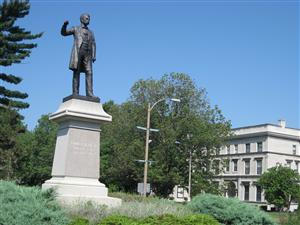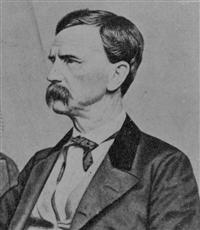
Directions: The Francis P. Blair, Jr. Statue [ Waypoint = N38 38.636 W90 15.952 ] is located in the extreme northeastern corner of Forest Park near the intersection of Lindell Boulevard and Kingshighway Boulevard.
Description: The statue's west side inscription reads as follows:
This monument is raised to commemorate the Indomitable free-soil leader of the west; the herald and standard bearer of freedom in Missouri; the creator of the first volunteer Union army in the South; the saviour of the state from secession; the patriotic citizen-soldier, who fought from the beginning to the end of the war; the magnanimous statesman, who, as soon as the war was over, breasted the torrent of proscription, to restore to citizenship the disfranchised Southern people, and finally, the incorruptible public servant.

Born in Kentucky, Francis P. Blair, Jr. was a Representative in the United States house of Representatives from the State of Missouri at the beginning of the American civil War. In 1861, Frank Blair raised the First Missouri Volunteer Infantry Regiment to help defend the state against Missouri secessionists. Frank Blair rose to the rank of Major General of Volunteers and would command divisions in the armies of Major Generals Ulysses S. Grant and William T. Sherman. After the war, Blair was the Democratic candidate for Vice President of the United States running on the ticket of presidential candidate Horatio Seymour. In 1871, Blair was elected to represent Missouri in the United States Senate where he served until his death in 1872.
The statue, designed by Wellington W. Gardner, is bronze and stands nine feet tall. It was dedicated by William Tecumseh Sherman on May 21, 1888 who said the following about Frank Blair: [27]
I have been with Frank Blair when the thunder of artillery would make the storm which has swept over us seem as the rumbling of distant wagons . . . I assure you that he was worthy of the honor you do his memory in the heroic statue which stands before us at this moment . . .[he] did more than any single man to hold this great central city of our Union to her faithful allegiance to the General Government, so necessary to the perpetuity of the Union.